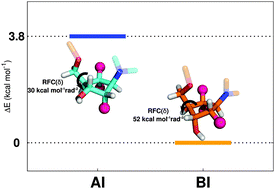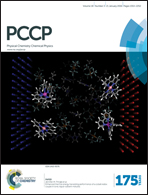Nucleotides containing variously modified sugars: energetics, structure, and mechanical properties†
Abstract
The influence of various sugar residue modifications on intrinsic energetic, conformational, and mechanical properties of 2′-deoxyribonucleotide-5′-monophosphates (dNs) was comprehensively investigated using modern quantum chemical approaches. In total, fourteen sugar modifications, including double bonds and heteroatoms (S and N) inside the sugar ring, as well as fluorination in various positions, were analyzed. Among hundreds of possible conformational states of dNs, only two – AI and BI, corresponding to the most biologically significant forms of a double-helical DNA, were considered for each dN. It was established that the most of the studied modifications tend to strongly stabilize either AI or BI conformation of dNs both in the gas phase and in aqueous solution (modelled by implicit solvent models). Therefore, some of these modifications can be used as a tool for reducing structural polymorphism of nucleic acids in solution as well as for designing oligonucleotides with specific structural features. The evaluation of relaxed force constants (RFC) for glycosidic bonds suggests that the majority of the studied modifications of the sugar residue yield increased strengths of glycosidic bonds in dNs, and can therefore be used for designing modified nucleic acids with an increased resistance to abasic lesions. The most significant reinforcement of the glycosidic bond occurs in dNs containing the CF2 group instead of the O4′ oxygen and the fluorine atom at the 2′-α-position. The calculation of the RFC and vibrational root-mean-square (VRMS) deviations for conformational degrees of freedom revealed a strong dependence between mechanical properties of dNs and their energetic characteristics. In particular, electronic energies of AI and BI conformers of dNs calculated in vacuo are closely connected with the values of relaxed force constants (RFC) for the δ angle: the higher RFC(δ) values correspond to more energetically favorable conformers.



 Please wait while we load your content...
Please wait while we load your content...